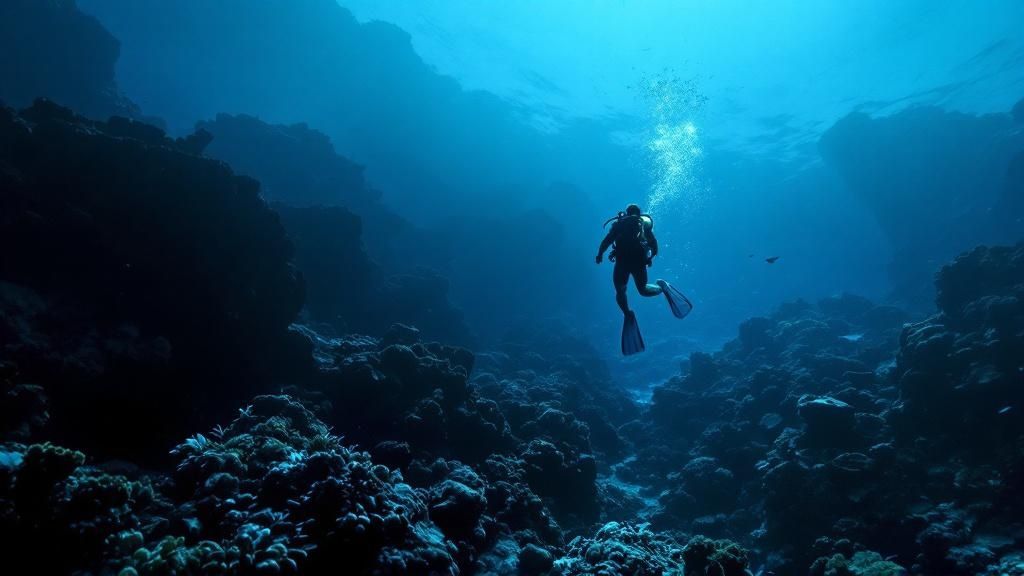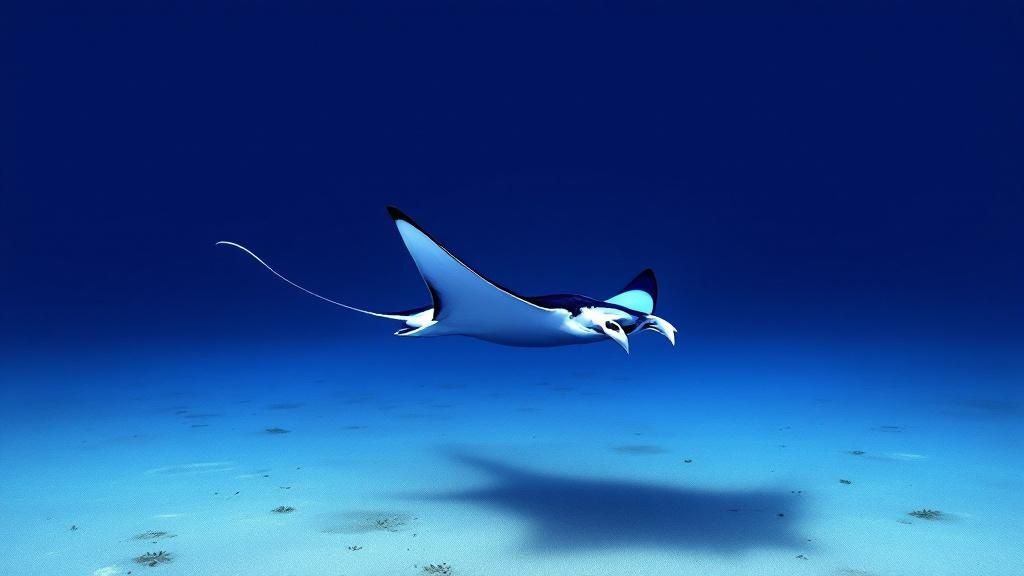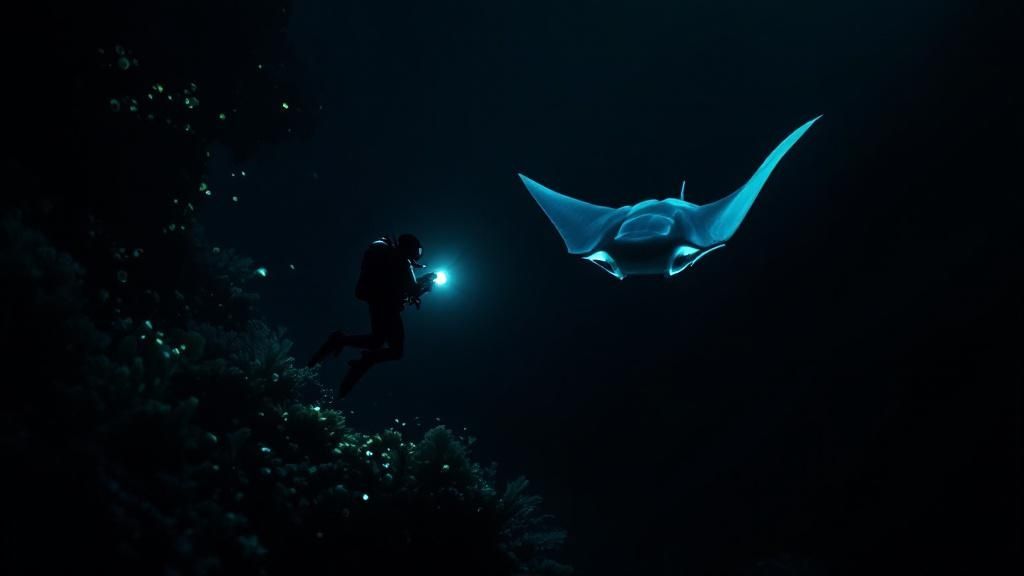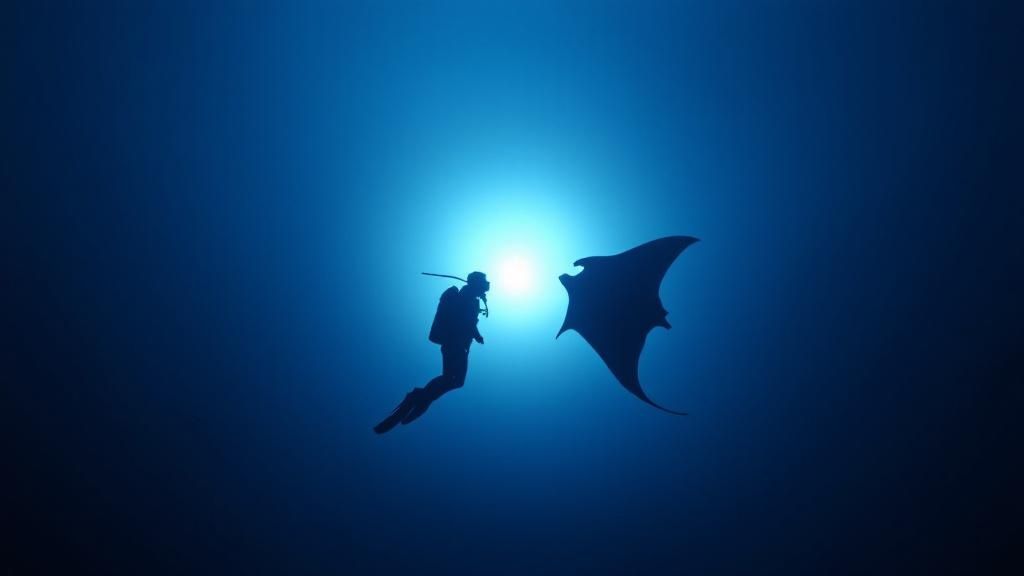The Kona manta ray dive isn't just another dive; it's consistently ranked as one of the most incredible underwater experiences you can have, anywhere in the world. What makes it so special? The Kona coast is one of the few places where you can reliably see these gentle giants year-round in a spectacular nighttime feeding frenzy.
What Makes the Kona Manta Ray Dive Unforgettable
The real magic of this dive isn't just spotting a cool animal. It's about being part of an otherworldly underwater ballet.
Picture this: you descend into the warm Pacific as the last light of day disappears. You settle on the sandy bottom, and your guide shines powerful lights up into the water column. This "campfire" of light instantly attracts clouds of plankton, which is exactly what the mantas are here for.
Then, the show starts. Out of the darkness, massive, graceful figures emerge. With wingspans averaging 12 feet, they glide effortlessly into the beams of light, performing mesmerizing barrel rolls just inches from your face. Their giant mouths are wide open as they filter the plankton-rich water. It's a surreal, almost spiritual experience that feels like a direct connection to the raw life of the ocean.
Kona's Two Premier Manta Dive Sites
Kona is blessed with two world-class locations for this encounter, and each offers a slightly different vibe. The one you choose often comes down to your experience level and the kind of adventure you’re after.
- Manta Village: Just south of Kailua-Kona, this is the original manta dive spot. The waters here are generally shallower and calmer, making it an excellent choice for divers of all levels, and even for snorkelers. It’s famous for consistent, up-close encounters.
- Manta Heaven: Located north, closer to the airport, this site (also known as Garden Eel Cove) can sometimes have a bit more current and is slightly deeper. It’s a favorite for more experienced divers and underwater photographers who are looking for a different dynamic and sometimes even larger groups of mantas.
The real secret to Kona's fame is the consistency. This isn't one of those wildlife encounters where you cross your fingers and hope for the best. Your chances of a mind-blowing show are incredibly high, which is why it’s a non-negotiable bucket-list item for divers around the globe.
The reliability here is truly astounding. Every year, around 80,000 people flock to the Kona Coast just for this dive, drawn by the near-guarantee of an amazing show. During the peak months from April to October, it’s common for groups to see 8 to 12 individual manta rays on a single trip.
This predictable gathering has made the Kona coast a global hub for manta ray tourism and research, giving us an amazing window into the lives of these creatures. For a full rundown of what the experience is like, take a look at our complete guide to the manta ray night dive in Kailua-Kona.
How to Choose the Right Manta Ray Tour Operator

Picking the right company for your manta ray dive in Kona is probably the biggest decision you'll make in this whole process. It's the one thing that truly shapes the safety, quality, and even the ethics of your adventure. A great operator delivers a night you'll never forget, while a bad one can leave you feeling let down or, even worse, put you in an unsafe situation.
The absolute first thing to look for is a company that puts the mantas' welfare first. You want operators who are committed to responsible tourism guidelines. This means they practice passive observation and use proper lighting—techniques designed to protect these incredible animals from stress and harm.
Vet Operators Like a Pro
Once you've got a shortlist, it's time to do some real digging. Don't let a slick website with cool photos be the only thing you go on. You need to look for evidence of a truly professional and safety-first operation.
A good company’s website will be upfront about its safety protocols, what the boat is like, and exactly what’s included in the price. They should also be clear about their "manta guarantee." While it’s rare for the mantas to be a no-show, it can happen. The best operators will offer to re-book you for free on another night if the mantas don't appear.
Before you hand over your credit card, actually call them or shoot them an email with a few key questions:
- What is your guide-to-guest ratio? A smaller ratio, something like 1 guide for every 6-8 guests, means you get more personal attention in the water.
- What’s your weather cancellation policy? Kona's weather can turn on a dime, so it's good to know your options.
- Are wetsuits included, and what thickness are they? Being cold is a surefire way to ruin a dive. A 3mm or 5mm wetsuit is what you should expect.
The answers you get—and how quickly and professionally they give them—will tell you volumes about their customer service.
Match the Tour Style to Your Needs
Not all manta ray tours are the same. The boat you're on and the size of your group can completely change the experience. Think about what kind of vibe you're looking for before you book.
The choice between a big, stable catamaran and a small, zippy charter boat is more than just about the price. It’s about creating the exact adventure you have in mind, whether that's a social party atmosphere or an intimate wildlife encounter.
To help you figure out what's best for you, let's break down the common types of manta ray tours you'll find in Kona.
Comparing Kona Manta Ray Tour Operators
Choosing an operator is about matching their style to your personal preference. Are you looking for a lively social outing, or a quiet, focused dive? This table compares the different types of boats to help you decide.
| Feature | Large Tour Operators | Small Charter Boats | Snorkel-Only Boats |
|---|---|---|---|
| Best For | Families, beginners, and anyone on a budget who enjoys a social atmosphere. | Serious divers, photographers, and small groups looking for a personalized trip. | Non-divers or families with young children who want a simpler, surface-level experience. |
| Group Size | Typically larger, hosting 20+ passengers on spacious catamarans. | More intimate, often capped at 6-12 passengers, which means a focused trip. | Can range from small rafts to large boats, accommodating various group sizes. |
| Vessel Type | Big, stable catamarans with plenty of room, restrooms, and even hot showers. | Varies from rigid-hull inflatables (Zodiacs) to smaller, custom-built dive boats. | Often custom-built vessels with easy water access and large "manta floatboards." |
| Overall Vibe | Upbeat and energetic, with a fun, party-like feel. | Generally quieter and more focused on the diving and marine life interaction. | Casual and accessible, centered on a fun and safe viewing experience from the surface. |
Ultimately, knowing what you want is the key. If a comfortable ride with lots of amenities sounds good, a larger boat is a perfect choice. But if you're after a more adventurous, tight-knit experience with a dedicated crew, a small charter is the way to go.
Making an informed choice here sets you up for a successful and memorable night before you even step on the boat. To get a better feel for what makes this experience so unique, check out our article on why you should go on a manta ray dive in Kona.
Getting Ready for Your Underwater Adventure

The difference between a good manta ray dive in Kona and an absolutely mind-blowing one often comes down to a little bit of prep work. If you know what to bring and what to expect before you even leave for the dock, you can just relax and soak in the magic once you're on the boat.
Most professional dive shops will have you covered with the big stuff: BCD, regulator, fins, and a wetsuit. But after years of diving, I can tell you that a few personal items are worth their weight in gold for making the experience seamless.
A well-fitting mask is the most important piece of gear you can bring. Seriously. Nothing ruins a dive faster than a leaky mask that you're constantly clearing while giant mantas are doing acrobatics right in front of you. Bringing your own ensures you have a perfect seal. I also always recommend bringing your own dive computer if you have one. While it's not a deep dive, using gear you're familiar with is always a smart move.
What to Pack in Your Dry Bag
A few small things can make a huge difference, especially after the dive. You’ll be surprised how chilly that boat ride back to shore can feel after the sun goes down.
- Towel and Warm Clothes: Don't underestimate the post-dive chill. A dry towel and a warm sweatshirt or jacket are your best friends for the ride back to the harbor. You’ll thank me later.
- Seasickness Medication: If you have even the slightest suspicion you might get seasick, take your preferred remedy before you board. It’s a lot less effective once you're already feeling queasy.
- Reusable Water Bottle: Staying hydrated is crucial for a good dive. Bringing your own bottle is not only practical but also helps cut down on plastic waste.
- Certification Card: Make the check-in process smooth and quick. Have your physical or digital certification card ready to show the dive staff.
Your pre-dive briefing is the most important part of the tour before you get wet. This isn't just filler—it's where the crew explains the plan, the safety rules, and exactly how to interact with the mantas respectfully. Listen carefully.
Tips for Underwater Photographers
Photographing the manta ray ballet is an incredible challenge, but so rewarding when you get it right. The key is having the right gear and the right attitude.
Go for a wide-angle lens. You'll need it to capture the massive wingspan of a manta gliding just inches above you. Since strobes and flashes aren't allowed (they can disorient the animals), you're at the mercy of the big lights the crew sets up. This means you need to be ready for low-light shooting. I usually start with my ISO cranked up to 1600-3200 and open up my aperture as wide as it will go (think f/2.8 or lower).
The single best piece of advice? Let the mantas come to you. Never chase them for a shot. Find your spot on the sandy bottom, get comfortable, and be patient. The best photos come when the mantas glide gracefully into your frame, and this patient approach is what keeps the experience safe and respectful for everyone in the water.
How to Be a Good Guest in the Manta's World

Dropping into the ocean at night to witness the manta ray ballet is a privilege. To keep this experience magical for everyone—and safe for the mantas—we need to be respectful guests in their home. The entire manta ray dive Kona encounter is built on one core idea: passive interaction. You're there to watch the show, not be a part of it. Think of yourself as a silent, stationary rock on the seafloor, letting the magic unfold around you.
The absolute golden rule? Never, ever touch a manta ray. Their skin is coated in a delicate, slimy mucus that acts as their immune system, warding off nasty bacteria and infections. When you touch them, you strip away that protective layer, leaving them vulnerable to disease. It's like breaking a hole in their shield.
And remember, their home is our responsibility. Understanding how to stop water pollution is a key part of being a conscientious diver and ensuring these waters remain a healthy sanctuary.
Finding Your Place in the "Amphitheater"
The best views come to those who wait. Your dive guide will get you settled on a sandy patch on the ocean floor. Once you're in position, stay put. The mantas are naturally curious and will feel comfortable gliding right over your head if you're still. If you chase them, they'll bolt, and that ruins the experience for the entire group.
This is where solid buoyancy control becomes your superpower. You need to be able to hover without kicking up sand or drifting into your neighbor. It’s not just about protecting the fragile ecosystem; it’s about making sure you don't accidentally bump into a 1,000-pound animal or another diver in the dark.
“The ‘campfire’ formation isn’t just for attracting plankton; it’s a brilliant safety and viewing strategy. By arranging divers in a circle with lights pointing up, we create a centralized stage that draws the mantas in while keeping the group organized and aware of each other’s positions.”
This clever setup is the secret sauce. It turns a group of individual divers into one giant, plankton-attracting beacon, which is exactly what brings the mantas to the dinner table.
The Ground Rules for a Safe Encounter
Following the safety briefing isn't just a suggestion—it protects you, the mantas, and the future of this incredible dive. Your guide is the expert in the water; stick with them and listen to their instructions. They know this dive site and the animals' behavior like the back of their hand.
Here are the non-negotiables for a safe and respectful dive:
- Lights Point Up: Your dive torch should always be aimed toward the surface. This creates the column of light that attracts the plankton. Never shine it in a manta's eyes or at other divers.
- Stay Low: Stick to the sandy bottom. This keeps the water column open, giving the mantas plenty of room to perform their famous barrel rolls.
- Mind Your Bubbles: Try to exhale when a manta isn't directly overhead. A face full of bubbles can be startling and may cause them to veer away.
This level of organization and respect is why the Kona Coast boasts a phenomenal sighting success rate of 80% to 90%. The mantas keep coming back because the interactions are consistent and non-threatening. When you follow these simple rules, you're not just a tourist; you're actively helping to sustain one of the world's greatest wildlife encounters. You can dive deeper into the data on Kona Honu Divers' manta ray page.
What the Manta Ray Ballet Actually Feels Like

Trying to describe the Kona manta ray dive is a bit like trying to explain a beautiful song to someone who can't hear. Words just don't quite capture it. The experience starts with a complete change of scenery. You leave the fiery Hawaiian sunset behind and slip into a world of deep, silent indigo. The only sounds are the steady hiss of your own breathing and the soft gurgle of bubbles making their way to the surface.
Once you’re settled on the sandy ocean floor, you become part of the audience in a massive, dark theater. And then, the show begins. Your dive master and the others in your group will shine powerful lights up toward the surface. This creates a cone of light—what we affectionately call the "campfire"—that immediately illuminates a swirling universe of tiny plankton.
The Grand Entrance
At first, things are quiet. A few small fish might zip through the light beam, and you wait. Then, you see it. A shadow emerges from the darkness, a form so huge and impossibly graceful it can only be one thing. The first manta ray glides into the light, not with a jolt, but with a silent, commanding presence that literally steals your breath.
Before you know it, another joins, and then another. They aren't just swimming; they're dancing. They perform these huge, slow-motion barrel rolls, swooping through the cloud of plankton with their giant mouths wide open. They come so close you can see the unique spot patterns on their bellies—each one a natural fingerprint that helps researchers and seasoned guides tell them apart. It's a surreal and powerful sight.
It's an overwhelming feeling of smallness and connection all at once. You're a guest at an ancient, underwater banquet, witnessing a spectacle that has unfolded in these waters for millennia. The experience transcends simple observation; it feels deeply personal and profound.
This nightly ballet isn't just magical; it's a vital part of the local ecosystem and economy. Every year, an estimated 80,000 people come to witness this, which provides a powerful incentive for conservation. On a good night, you might see between 50 and 150 different mantas, a stunning testament to how healthy the Kona population is. This incredible spectacle helps fund the very efforts needed to protect these gentle giants.
A Connection Beyond Words
As they soar just inches over your head, you can feel the gentle push of water from their massive wings. At some point during the dive, you’ll swear one of them looks right at you. Mantas are incredibly intelligent and curious animals, and that moment of eye contact—of being truly seen by this wild, majestic creature—is what stays with you long after you surface.
It's a humbling, mind-quieting experience that fills you with pure wonder. You’re not just watching nature; you’re a part of it. To get ready for an encounter that many describe as life-changing, check out our guide on how to plan the perfect manta ray night dive in the Big Island.
Common Questions About the Kona Manta Ray Dive
https://www.youtube.com/embed/t1zYd0WaLEc
Even after you've decided to go for it, a few questions always pop up about the manta ray dive in Kona. It's smart to get these sorted out ahead of time so you can just relax and soak in the experience once you're there. Let's run through some of the things people ask most often.
One of the biggest questions I hear is, "Do I have to be a certified scuba diver?" And the answer is a big, happy no! While the dive itself is for certified divers, there are fantastic manta ray snorkel tours that get you just as close to the action.
On a snorkel trip, you'll typically hold onto a large, custom-built float board. Powerful lights shine down from the board, attracting the plankton and, in turn, the mantas. You get a stunning bird's-eye view as these gentle giants glide and barrel roll right beneath you. It’s an incredible option for non-divers, families, or anyone not quite ready for scuba.
What if the Mantas Don't Show Up?
This is a totally fair question—we are talking about wild animals, after all. The good news is that the Kona coast has an astonishingly high success rate, with mantas making an appearance on over 90% of all tours. The resident population is so reliable that a "no-show" night is extremely rare.
But what happens if you're on one of those very few unlucky trips? Most reputable operators have what they call a "manta guarantee." In a nutshell, this usually means you can come back another night for free.
Insider Tip: Always try to book your manta tour for one of your first nights in Kona. That way, if bad weather cancels the trip or you hit that rare no-manta night, you have plenty of time in your vacation schedule to rebook.
This guarantee shows just how confident the local crews are. Just be sure to double-check the specific policy with whatever company you book with, but it's a very common and reassuring practice.
Are There Options for Kids and Non-Swimmers?
Absolutely! The manta encounter is designed to be an adventure for almost everyone. As I mentioned, snorkeling is the perfect choice for families and anyone who isn't a strong swimmer. The float boards offer a ton of stability, so you can just hold on and watch the show in comfort.
For anyone who prefers to stay completely dry, many boats offer a "ride-along" option. You get to enjoy a beautiful Kona sunset cruise, feel the buzz of excitement on the boat, and watch everyone else get in the water. It’s a great way to be part of the experience without getting wet.
You can also check out the Manta Learning Center at the Outrigger Kona Resort. From its deck, you get a fantastic view of the Manta Village dive site. It’s a cool way to learn about the mantas and maybe even see them from shore.
Ready to see the underwater ballet for yourself? Kona Honu Divers runs world-class, safe, and respectful manta ray dives and snorkels with a fantastic, experienced crew. Book your unforgettable adventure today!
